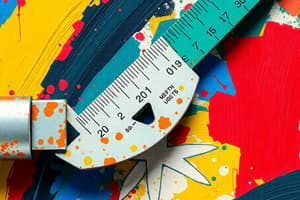Podcast
Questions and Answers
What is the SI unit of volume?
What is the SI unit of volume?
- Cubic-metre (m3) (correct)
- Litre (l)
- Cubic-centimetre (cm3)
- Millilitre (ml)
How is the volume of a rectangular block calculated?
How is the volume of a rectangular block calculated?
- length + breadth + height
- length x breadth - height
- length^2 + height
- length x breadth x height (correct)
What is the equivalent of 1 millilitre in cubic centimetres?
What is the equivalent of 1 millilitre in cubic centimetres?
- 10 cm3
- 1 cm3 (correct)
- 0.1 cm3
- 100 cm3
How should a measuring cylinder be positioned when measuring liquid volume?
How should a measuring cylinder be positioned when measuring liquid volume?
What measurement technique is used to find the volume of an irregularly shaped solid?
What measurement technique is used to find the volume of an irregularly shaped solid?
What is the formula for calculating the volume of a sphere?
What is the formula for calculating the volume of a sphere?
How many millilitres are there in one litre?
How many millilitres are there in one litre?
Which method should be used to avoid parallax error when reading the volume in a measuring cylinder?
Which method should be used to avoid parallax error when reading the volume in a measuring cylinder?
Which formula is used to find the volume of a cylinder?
Which formula is used to find the volume of a cylinder?
What is the relationship between cubic metres and cubic centimetres?
What is the relationship between cubic metres and cubic centimetres?
Flashcards are hidden until you start studying
Study Notes
Measurement Errors and Techniques
- To minimize Parallax error during measurement, ensure that the line of sight is perpendicular to the reading.
Measuring Instruments for Length
- Micrometer Screw Gauge: Accuracy of 0.01 mm, used for very short lengths like the diameter of a metal wire.
- Vernier Calipers: Accuracy of 0.01 cm, suitable for short lengths such as the diameter of a measuring cylinder.
- Metre Rule: Accuracy of 0.1 cm, appropriate for medium lengths, e.g., image distance of a lens.
- Measuring Tape: Accuracy of 0.1 cm, used for long lengths like those in a physics laboratory.
Area Calculations
- Rectangle: Area = length × breadth
- Triangle: Area = ½ × base × height
- Circle: Area = π × (radius)²
- SI unit of area: square metre (m²); 1 cm² = 10⁻⁴ m².
Volume Overview
- Volume represents the space occupied by an object.
- SI unit of volume: cubic metre (m³); 1 cm³ = 10⁻⁶ m³.
- Common conversions: 1 litre (l) = 1000 ml = 1000 cm³.
Physical Quantities
-
Physical Quantity: Measurable or calculable from physical properties; expressed as a product of a number and a unit.
-
Basic Quantities: Fundamental quantities that cannot be derived from others. Examples include:
- Length: metre (m)
- Mass: kilogram (kg)
- Time: second (s)
- Current: ampere (A)
- Temperature: Kelvin (K)
- Amount of substance: mole (mol)
- Luminous intensity: candela (cd)
-
Derived Quantities: Expressible in terms of other physical quantities, such as area, volume, and density.
Volume Calculation for Regular Shapes
- Rectangular Block: Volume = length × breadth × height
- Sphere: Volume = (4/3)π × (radius)³
- Cylinder: Volume = π × (radius)² × height
Volume Measurement in Liquids
- Volume measured in litres (l); to measure:
- Pour liquid into a measuring cylinder.
- Ensure the cylinder is upright on a level surface.
- Read the scale at eye level, perpendicular to the lower meniscus to avoid Parallax error.
Volume Measurement for Irregular Solids
- Use water displacement method:
- Fill a measuring cylinder and note the initial water level.
- Immerse the solid and record the new water level.
- The difference gives the volume of the irregular solid.
Studying That Suits You
Use AI to generate personalized quizzes and flashcards to suit your learning preferences.




